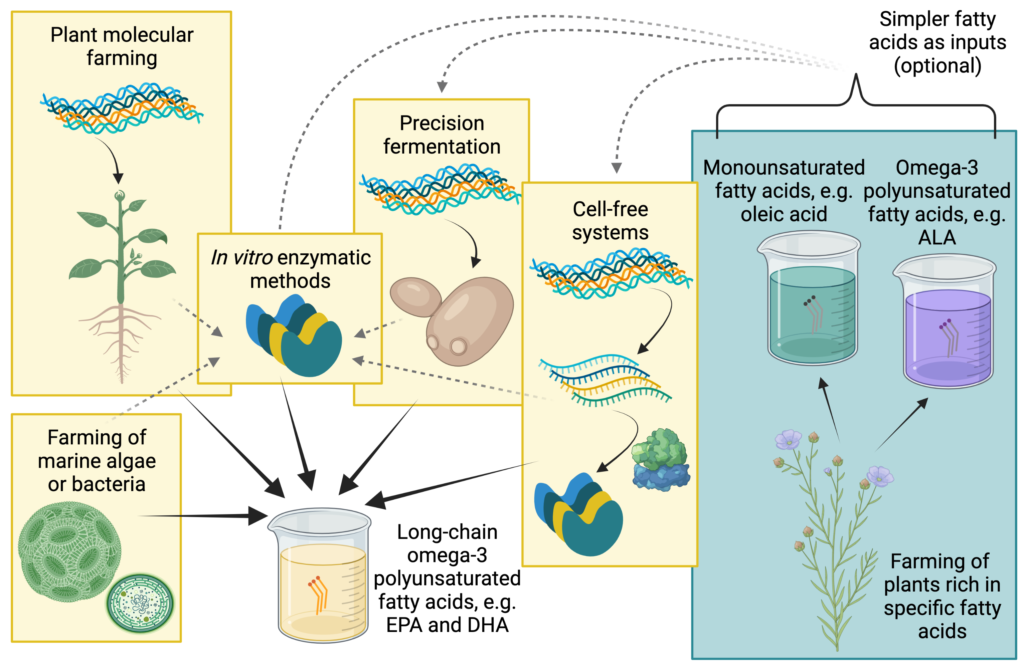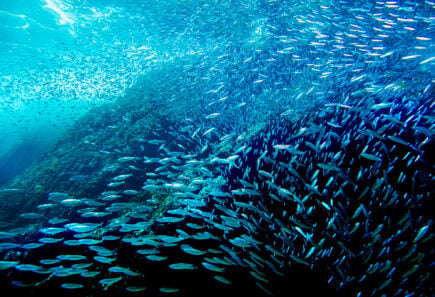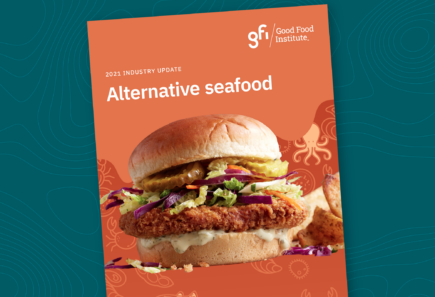Affordable animal-free omega-3 ingredients for alternative seafood and other alternative protein applications
In order to appeal to health-conscious consumers, alternative seafood products should contain similar omega-3 fatty acids, especially DHA and EPA, content to conventional seafood. Animal-free omega-3 ingredients can be expensive and supply can be inconsistent. Scaling up animal-free omega-3 production is critical to the success of the global alternative seafood market, which is seeing increased attention and promising growth. Adding omega-3 to other alternative protein products could also provide a great point of differentiation while improving health appeal.
-
Fermentation
-
Plant-Based
- Commercial
- Investment
- Production
- R&D
- Raw Materials, Ingredients, & Inputs
- Bioprocess design
- Crop development
- Host strain development
- Ingredient optimization
- Target molecule selection
- Industry
- Investors
- Startups
Current challenge
Alternative seafood is a largely untapped market whitespace. Plant-based seafood sales account for only 0.1 percent of seafood retail sales in the U.S., compared to plant-based meat, which accounts for 1.4% of U.S. retail meat sales. However, 2020 retail sales increased by 24 percent relative to 2019 and investment in alternative seafood has grown continuously over the last four years as investors increasingly identify the significant opportunity alternative seafood presents.
GFI surveyed alternative seafood companies to understand the challenges they face with regards to incorporating animal-free omega-3 ingredients into their products. The majority of companies are using supplement-grade algal omega-3’s which are sold at a premium. The following challenges are based on the survey results and existing literature:
- Cost is a leading barrier to including omega-3s in products, especially as companies scale. Algae oil with 40 percent DHA costs up to $60.00 per kilogram, which would add $1.85 to the cost of one kilogram of alternative salmon.1
- The quality of omega-3 ingredients is inconsistent.
- Companies are experiencing long lead times from omega-3 vendors.
- Some algal omega-3s have a significant off-taste and short shelf life.
- Capacity is limited. For example, the seaweed industry in Maine–which is where the majority of seaweed is grown in the U.S.–is restricted by a lack of processing capacity.
There is a need for a more robust supply chain for animal-free omega-3s as ingredients for all three alternative protein production platforms, cultivated, fermentation-derived and plant-based. This will help the alternative seafood industry drive costs down and eventually achieve price and nutritional parity with conventional seafood.
More companies focused on producing and processing animal-free omega-3 ingredients from algae or other sources are needed to support the growth of the alternative protein industry. If alternative seafood replaced one percent of total global seafood production, the quantity of EPA and DHA needed for those alternative seafood products to reach omega-3 parity with conventional seafood are:
- 3502.13 tonnes EPA per year
- 6470.38 tonnes DHA per year2
In 2018, a total of 111,210 tonnes of omega-3 ingredients, both animal-free and fish-derived, were sold globally. This estimate, from the Global Organization for EPA and DHA Omega-3s, comes to about a $1.38 billion market. The report lists the global market size for algal oil specifically at 2,034 tonnes. Therefore, if the entire global algae-based omega-3 supply were diverted to alternative seafood production, it would only be sufficient for the production of enough nutritionally similar products (taking into account only EPA and DHA content) to account for 0.2% of the global seafood market.
Comparatively, according to a 2009 report from the FAO (Food and Agriculture Organization), one million tonnes of fish oil per year were produced globally. 80 percent of the global supply of fish oil was used for aquaculture feed. The report estimates that the aquaculture industry used an estimated total of 210,000 tonnes of EPA and DHA per year in the form of fish oil and fish meal.
Notes:
- This estimate only includes DHA, not EPA and is based on publicly-available prices from Qingdao Fortune Environmental Technology Co., Ltd. via www.alibaba.com . Calculation: $60/kg algae oil * (kg oil / 0.4 kg DHA) * (kg DHA / 1,000 g DHA) * (1.23 g DHA / 100 g edible salmon) * (1,000 g edible salmon / kg edible salmon) = $1.85 per kg edible salmon
- Calculations behind market sizing:
- The data came from GFI’s ArcheType Library for Alternative Seafood (ATLAS) and the FAO/INFOODS (International Network of Food Data Systems) Global Food Composition Database for Fish and Shelfish, uFish.
- These numbers are based on calculations using 2018 U.S. import data and nutritional data on EPA and DHA content of popular seafood species.
- After sizing the U.S. market, we took the total weight of seafood produced globally and scaled the U.S. numbers up proportionally. For the U.S. market sizing, there are some archetypes for which we didn’t have data on omega-3 content meaning that the numbers are an underestimate.
- Other fatty acids besides EPA and DHA are not included.
Proposed solution
New entrants, increased capacity from existing companies, and new efforts by related companies are all needed to grow the animal-free omega-3 market. The market is currently fragmented, making it easier for new companies to enter. The fragmented market also provides opportunities to differentiate and innovate. Further, no companies dominate the animal-free omega-3 market specifically for alternative proteins. More companies producing these ingredients will fill a much-needed niche in the alternative protein and ingredient markets and play a significant role in helping alternative seafood reach price and nutritional parity with conventional seafood.
New entrants to the market can produce animal-free omega-3 through a variety of sources. Three promising sources are:
- Certain species of marine algae & bacteria are known to produce long-chain omega-3 fatty acids in substantial quantities. These organisms can be farmed at scale for the purification of long-chain omega-3 fatty acids.
- Plant molecular farming is the production of various desirable compounds through the genetic modification of plants. In this case, the insertion of several genes required for the conversion of simpler fatty acids to long-chain omega-3 polyunsaturated fatty acids (PUFAs) would be required in order to produce a strain of plants from which the desired long-chain omega-3 PUFAs can be purified.
- Flax oil contains shorter-chain omega-3s like ALA, which are nutritionally valuable on their own, and also could serve as precursors for elongation by hepatocytes, engineered microbes, or cell-free methods.
Existing and potential strategies for the synthesis of long-chain omega-3 PUFAs (orange panels). Simpler fatty acids can also be used as inputs, most likely from the farming of terrestrial crops (green panel).

Anticipated impact
A larger, more established supply of animal-free omega-3s will help alternative seafood companies reach price and nutritional parity with conventional seafood. Because consumers consider both price and health benefits when choosing conventional and alternative seafood, animal-free omega-3s have the potential to accelerate the growth of the alternative seafood industry.
The majority of the cultivated seafood companies surveyed by GFI are working toward nutritionally enhanced products, such as seafood, with greater omega-3 content than cultivated seafood. Given the emphasis that many seafood consumers place upon the health properties of seafood, such a move could substantially increase the size of the omega-3 market.
Related efforts
Some companies are already working on animal-free omega-3 ingredients and have indicated interest in supplying alternative protein. For example, Rothamsted Research has produced plant-based omega-3 fatty acids by genetically modifying the common commodity crop camelina to synthesize EPA and DHA. Several companies, including Algarithm, DSM, iWi, and Corbion, produce omega-3 ingredients using algae and demonstrated interest in supplying their products as ingredients to the alternative protein sector. There are also several companies in the fermentation space working on fats for alternative protein more broadly, including Nourish Ingredients, C16 Biosciences, and Melt & Marble.
Research related to this solution:
- Algal omega-3 market projections
- Strategies for increasing PUFAs in marine bacteria
- Canola variety, genetically engineered to convert oleic acid to DHA and EPA, as well as for resistance to an imidazolinone herbicide.
- Microalgae for aquafeed
- Sustainable source of omega-3 eicosapentaenoic acid from metabolically engineered Yarrowia lipolytica
- Production of omega-3 eicosapentaenoic acid by metabolic engineering of Yarrowia lipolytica (Xue et al. 2013)
Additional resources:
GFI resources

Sustainable Seafood Initiative
Learn how plant-based, fermentation-derived, and cultivated seafood can improve the health and sustainability of oceans.

State of the Industry Report: Alternative seafood
Our report explores the global alternative seafood industry’s commercial landscape and shares the latest on investments, sales data, and consumer insights.

Find collaborators
Join the GFIdeas global community of 2,000+ entrepreneurs, scientists, investors, and subject matter experts. Discuss projects on the members-only Slack community, attend monthly seminars, and use the community directory to help you find collaborators working on similar Solutions!
Related solutions
-
Cultivated
-
Fermentation
-
Plant-Based
Preventing oxidation of omega-3 fatty acids before and after addition to alternative seafood products
Deeper fundamental knowledge of the causes and prevention of oxidation of omega-3 fatty acids before, during, and after addition to alternative seafood products is needed to improve their nutritional and…
-
Fermentation
Novel methods for long-chain omega-3 fatty acid production
As the alternative seafood industry scales up, a low-cost and abundant source of long-chain omega-3 polyunsaturated fatty acids will become necessary. Several means of producing these compounds have been investigated…
-
Cultivated
Understanding uptake and interconversion of omega-3 fatty acids by cultivated fish cells
Although fish are one of the best dietary sources of long-chain omega-3 fatty acids (FAs), these compounds are mostly bioaccumulated from a fish’s diet rather than synthesized de novo. Consistent…

Explore the full solutions database
Browse 100+ startup ideas, commercial opportunities, research projects, and investment priorities throughout the alternative protein supply chain.
Get involved
If you’d like to fund a research project, work on any of these solutions, share information about related efforts that are already underway, or elevate new ideas for advancing the alternative protein industry, we’d love to hear from you!
